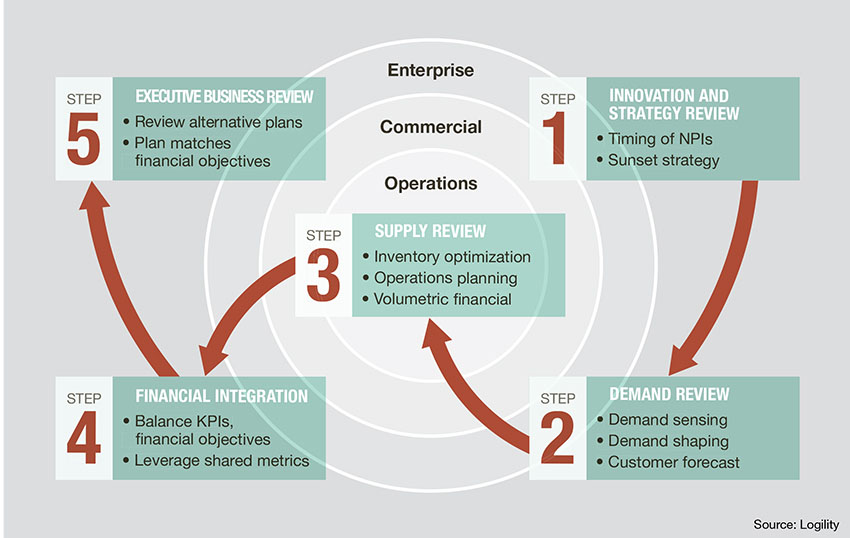Smoother execution through S&OP
The sales and operations planning process is a long-established mechanism for aligning business objectives with operations. Find out how planning solutions are becoming more constraint aware and capable of assessing what-if scenarios in ways that make S&OP more effective and meaningful.
Planning can seem like an arcane discipline to managers running warehouses or other points in a supply chain. That’s because, most days, operations managers are focused on executing in the here and now by fulfilling orders, dealing with stock shortages or expediting transportation.
Sure, every facility has plans, like min/max levels for SKUs, replenishment schedules and maybe even some local labor planning to assess if a distribution center can meet a peak season rush. The problem is, these plans may need to be frequently reworked, in part because, traditionally, long-range planning typically didn’t factor in execution-level constraints.
The remedy to these issues comes down to building a stronger bond between planning and execution. In short, making plans cognizant of constraints. That may seem like wishful thinking, but many companies already use a mechanism to do just that: a sales and operations planning (S&OP) process. The trick, of course, is how to make S&OP more effective, and thus more beneficial to managers in the trenches.
S&OP is a process rather than a technology. At its core, it’s about keeping operational resources in alignment with strategic business goals. According to supply chain association APICS, S&OP seeks to build advantage on a continuous basis by integrating customer-focused marketing plans for new and existing products with the management of the supply chain.
While many companies have had success with S&OP, there’s room for improvement in making S&OP more aware of key execution factors. For one thing, logistics and DC operations executives need input to the S&OP process, alongside others involved like sales, finance, sourcing and marketing leaders.
“S&OP is not just about planning, it’s about bringing together all the key stakeholders,” says Dwight Klappich, a research vice president with analyst firm Gartner. “Today, logistics needs to be one of those stakeholders, because it represents a major potential point of failure. So, one thing I would say to senior management is—make sure logistics gets a seat at the table.”
 The supply review step of an S&OP multi-step business process can involve assessing warehouse and logistics operations alternatives in light of constraints.
The supply review step of an S&OP multi-step business process can involve assessing warehouse and logistics operations alternatives in light of constraints.
Conversely, middle managers in logistics need to go beyond pride in being able to expedite. They also need to consider how to provide insights to S&OP teams about issues like inventory policies, or item/SKU stocking strategies that, when incorporated into plans, set the stage for success.
“While people are understandably busy running the supply chains they have, a new kind of necessity has emerged due to the pace of change in business, and that is, if I’m going to stay competitive, I must have a way to evolve as the market evolves,” says Toby Brzoznowski, a co-founder and executive vice president with LLamasoft, a supply chain software vendor. “I think companies realize they need to have the capability to adapt, to experiment and try new ideas in a digital environment that allows them to predict how they will perform.”
S&OP spans horizons
A major shift in S&OP over the last decade or two has been the analysis of more financial data and business what-ifs alongside demand and supply matching, according to Karin Bursa, executive vice president with Logility, a supply chain software provider. “One of the biggest opportunities that is different today for many companies than say, 15 years ago, is the inclusion of more financial data within S&OP,” Bursa says. “So, as S&OP engages more senior executives, your supporting software needs to be able to look at plans not only in volumetric terms—SKU quantities or cases—but also in the financial terms of the business.”
This more-evolved approach is referred to by many as integrated business planning (IBP). Typically done over a longer horizon than supply/demand matching under S&OP, IBP might examine alternatives such as whether a company should build a new plant, build or lease warehouse space, bring in contract manufacturers, or even acquire companies, says Bursa. Ideally, analytics for IBP should use the same data and planning models as software used for other horizons. “IBP is much more effective when you can use your current supply chain network as the foundation for those strategic plans,” Bursa says. 
Solutions at S&OP and integrated business planning (IBP) level should ideally integrate with supporting applications for planning and execution,with constraints folded into the planning model.
An S&OP process might leverage multiple planning tools, from modeling of longer-term IBP issues, and the more classic demand planning, inventory planning and replenishment planning. Again, says Bursa, planning should leverage a common data model, and it’s helpful if the vendor can offer a mechanism for cleansing master data from different systems. “Linking all of those time horizons together is a big part of the value proposition in sales and operations planning,” says Bursa.
The benefits of software for S&OP includes less time spent by planner in prepping data, but also better plans that move the needle toward better performance.
For example, Vista Outdoor, a manufacturer and marketer of sporting goods including brands such as Bushnell and Camelbak, has used Logility’s software to support S&OP. Since implementing Logility Voyager Solutions for S&OP in 2015, the company has cut the time for demand consensus preparation by 10%, increased in-stock rates by 14% on average, and reduced unplanned air expense by a third.
The modeling for supply chain network design can set a useful foundation for more operational-level planning, says Brzoznowski. Llamasoft’s network design modeling and data management platform is now being leveraged for mid- to shorter-term planning as well, he adds. “With many of our clients, out of the gate, they focus on creating models more for the one-time decisions, but then they realize that the same model can be used to support other decision cycles that happen quarterly, monthly or weekly,” he says.
Assess scenarios
While long-term network design looks at issues such as where to place DCs, shorter term analysis can examine questions such as where to position inventory in an existing DC network to meet a peak season or promotion, or how much space will be needed to fulfill orders for a peak season. Other what-ifs might look at whether it makes sense to consolidate certain SKUs at one DC.
“The S&OP process is all about looking at what-if questions,” says Brzoznowski. “You can’t really determine the answers to some of the questions unless you have a higher-level model of your entire supply chain network.”
Companies using Llamasoft’s solution include a large global retailer of athletic shoes, which uses Llamasoft Supply Chain Guru to model warehouse capacity and predict capacity requirements as part of a monthly S&OP cycle. Another user of the software is IEWC, a provider of interconnect products such as cables and wire management solutions. The company uses Supply Chain Guru for inventory optimization, using the model to regularly generate recommendations on stocking levels.
By using a consistent platform for everything from network design to shorter term planning, says Brzoznowski, enterprises can assess the ramifications of different scenarios on operational performance. This might include assessing the impact of a new, proposed service level on total landed cost, so that new promises such as same-day or next-day shipping don’t lead to unexpected costs.
Constraints up front
With integrated planning platforms available that can model constraints across horizons, S&OP can look at capacity constraints earlier on, says Salim Shaikh, senior solutions strategy director at JDA, which offers supply chain planning and execution solutions. “This whole siloed approach between planning and execution is collapsing,” Shaikh says. “We increasingly are getting toward constraint-aware planning.”
In the past, Shaikh says, some longer-term planning tools used models that were “unconstrained,” meaning they didn’t consider factors like carrier capacity, or warehouse space in the network, or warehouse labor or factory capacity. Now, says Shaikh, the software models that address an 18-month or even 24-month horizon can consider factors like transportation or DC capacity to assess what will be needed in time to secure lower cost contracts if more capacity is needed.
“We’re moving toward this constraint aware planning where organizations are looking at execution-level constraints further on out on the time horizon,” Shaikh says. “That’s significant, because if the organization doesn’t look at transportation or storage capacity until the tactical, short-term horizon, there’s only so much you can do.”
Another benefit of constrained plans for S&OP is that when the time to execute nears, changes to plans are smaller or not necessary. “If you make the right decisions further on out, then once those decisions roll into your tactical horizon, you won’t have to do as many changes,” says Shaikh.
Infineon Technologies AG, a semiconductor and systems solutions manufacturer, uses JDA’s software to support S&OP. The solution replaced the use of spreadsheets in S&OP planning, reduced the planning effort by 30%, while also reducing forecast adjustments by a factor of ten.
Another user of JDA’s S&OP solution, TE Connectivity, which makes connectors, switches and other electronic products, uses the software to model capacity requirements in S&OP for its automotive business unit. The modeling considers customer part number details, which gives improved visibility into capacity requirements. The solution is credited with helping TE Connectivity’s automotive business increase its ship-to-request performance by 8% year-over-year.
Ultimately, for managers in logistics to care about S&OP, the process needs to be inclusive of their priorities. It also helps if planning solutions are easy enough to use for non-planners who want to pose a what-if question without being experts in manipulating a planning tool, says Brzoznowski.
According to Gartner’s Klappich, the onus is on the executive team to ensure people in logistics and warehouse operations gain input into S&OP. As recently as a few years ago, Klappich recalls, when speaking to an audience of a couple of hundred logistics managers, he asked how many were involved in S&OP, and only a couple of people raised their hands. “Traditionally, logistics and warehousing people and their concerns have not had a dominant role in S&OP, but maybe it’s high time they have a bigger role,” says Klappich.
By getting involved in S&OP, says Brzoznowski, operations managers can ensure their insights get incorporated into scenario planning, which should give the enterprise time to adjust the makeup and capacity of the supply chain in time to make operations run more smoothly.
“I think operations people do need to care about S&OP,” says Brzoznowski. “You may be busy running the supply chain that you have, and dealing with existing capacity, but it can be helpful to take one step back and move one level up … and see if there are some smarter ways to do business or smarter ways to position inventory.”













